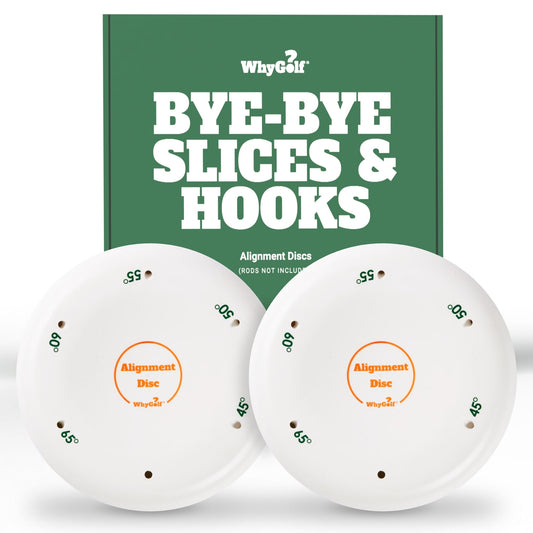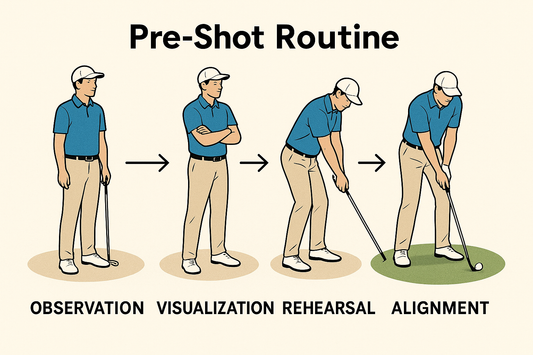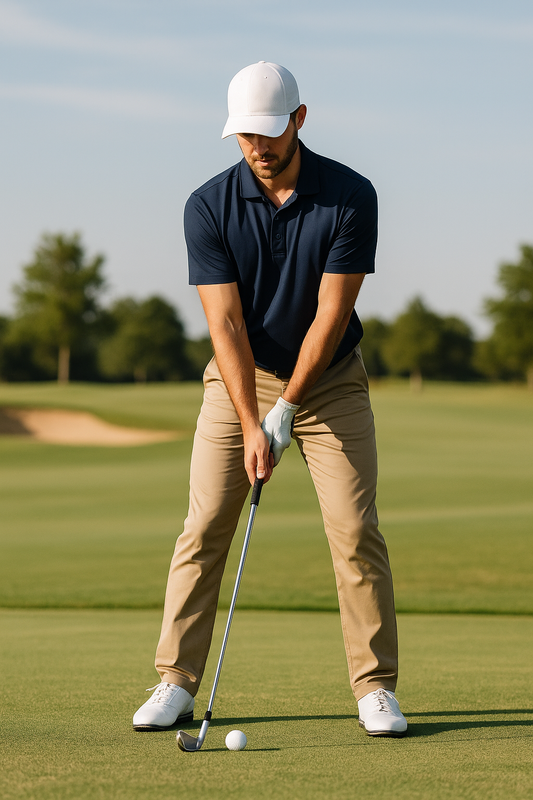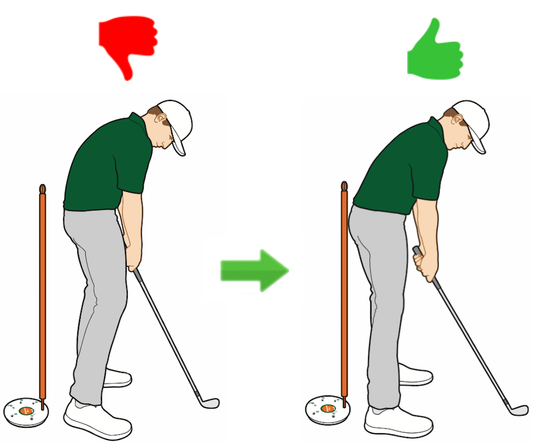Author: WhyGolf WhysGuy
We want to preface this guide with the acknowledgment that neither WhysGuy nor anyone from the WhyGolf team claims to know everything about the golf swing. We don’t want anyone to treat what we say here as gospel. While much of what we’ll say is a reflection of decades of dialogue with PGA instructors and players, we’re always learning and we understand that knowledge about the sport of golf will continue to evolve over time.
If you’re reading this, you probably struggle with making consistent contact with the golf ball.
Whether you're new to golf or an experienced player, getting the fundamentals right in golf is so important if you’re looking to improve your game.
In this comprehensive guide, we'll break down the essential elements of a proper golf swing - from setup to follow-through - helping you develop a reliable technique that will help you play your best.
The Importance of Proper Golf Ball Striking
Before diving into technique, it's worth understanding why proper ball striking matters. When you hit a golf ball correctly:
- You hit it farther with less effort
- Your shots become more accurate and predictable
- You reduce the risk of injury
- You develop consistency that translates across all clubs
- Your confidence increases, improving your overall game
Now let's examine each component of hitting a golf ball properly.
Setting Up for Success: Keys to Building Your Stance
Addressing Your Ball Position
The position of the ball in your stance varies depending on which club you're using:
- Driver and woods: Position the ball forward in your stance, roughly in line with the inside of your front foot
- Mid-irons (5-7): Place the ball between your left heel and middle of your stance
- Short irons (8-PW): Position the ball in the middle of your stance or slightly forward of center
- Wedges: Place the ball in the middle of your stance
Learn how to tell if your ball position is off and correct it.
Working On Correct Posture
- Finding yourself hitting pull hooks? It's possible your ball position is way too far forward in your stance.
- As we discussed earlier in this article, a forward ball position will generally cause your club's face angle to be pointed left at impact (for right-handers)
- If you move your ball position closer to the middle of your stance, your ball will likely begin starting out on line.
- Note: Since your ball was initially hooking, the downside to moving your ball position back is that your swing path may now be even farther to the right. Consider aiming your shoulders and feet a little left at setup to counteract this.
Grip Fundamentals
Your grip connects you to the club, making it arguably the most crucial element of your setup:
- Grip pressure: Hold the club firmly but not tightly—about a 5 or 6 on a scale of 10.
- Hand position: For a neutral grip, you should see 2-3 knuckles on your left hand (for right-handed golfers).
- Grip types: Choose between interlocking, overlapping, or ten-finger grip based on comfort and control.
The Perfect Golf Swing: Step by Step
Let's dive right into what the perfect golf swing looks like. You'll need it in order to hit the golf ball properly.
The Takeaway
The first 12-18 inches of your backswing sets the tone for everything that follows:
- Start by moving the clubhead, hands, and arms away from the ball as one connected unit
- Keep the clubface square to your target line
- Maintain your spine angle and avoid early wrist hinge
- Let your shoulders turn naturally as the club moves back
The Backswing
As you continue your backswing:
- Rotate your shoulders while maintaining your spine angle
- Allow your hips to turn naturally, but less than your shoulders (about 45 degrees)
- Keep your left arm relatively straight (for right-handed golfers)
- Hinge your wrists gradually as the club approaches the top position
- Shift some weight to your back foot, but maintain pressure on your front foot
At the top of your backswing, the club should be positioned roughly parallel to the ground (or slightly less with shorter clubs), with your wrists fully hinged.
The Transition
The transition from backswing to downswing is often where amateur golfers struggle most:
- Initiate the downswing with a slight lateral shift of your lower body toward the target. (think “bump”)
- Keep your arms relaxed and let them "fall" into the correct plane.
- Maintain the angle in your wrists on the downswing to avoid casting the club.
- Begin rotating your hips toward the target.
The Downswing and Impact
As you approach impact:
- Continue rotating your hips and shoulders toward the target.
- Shift your weight progressively to your front foot.
- Release the club through impact with your hands slightly ahead of the ball (forward shaft lean).
- Maintain a stable head position—avoid lifting up.
- Strike down on the ball with irons to create proper compression (the divot should be after the ball).
The Follow-Through
A proper follow-through indicates you've executed the previous steps correctly:
- Allow your body to continue rotating toward the target.
- Transfer your weight fully to your front foot.
- Let your back foot rise naturally onto your toe.
- Finish with your chest facing the target and the club behind your left shoulder (for right-handed golfers)
Common Mistakes When Hitting a Golf Ball
Even experienced players can fall into these traps. Watch out for:
Slicing
A slice (ball curving right for right-handed golfers) typically results from:a
- An open clubface at impact
- An outside-to-in swing path
- Poor grip with hands rotated too far to the left
Fix: Strengthen your grip slightly and focus on swinging more from the inside. If you’re looking for an easy way to fix your swing path, check out our Alignment Discs and Rods.
Topping the Ball
Hitting the top of the ball often happens because:
- You're lifting your head or upper body during the swing.
- Your ball position is too far back or forward in your stance.
- You're standing too far from the ball.
- You’re chicken winging through impact.
Fix: After checking your ball position, make sure you keep your arms extended through the impact area. If you’re looking for feedback on your arm structure, consider taking a look at our ArmAlarm.
Fat Shots
Hitting behind the ball can be caused by:
- Excessive weight on your back foot at impact.
- Ball position is too far forward.
- Your attack angle is too steep.
Fix: The most common cause of fat shots is an improper weight transfer. If you’re looking for real-time feedback on your weight shift, you’ll love our Pressure Plate + Power Wedge.
Practice Drills To Improve Ball Striking
Consider incorporating these drills and golf training aids into your practice routine:
Alignment Discs With Rods Drill
Using our Alignment Discs, you can set up a swing path station to create a channel for your club to swing through, encouraging the proper path. Additionally, you can practice hitting draws and fades depending on where you set the Discs.
Get Ball-First Contact With The Pressure Plate
Start with half swings with your weight forward, focusing on solid contact before progressing to full swings. This builds muscle memory for proper impact. Use our Pressure Plate + Power Wedge if you want to know where your weight is in real time.
Keep Arms Connected To Your Chest With ArmAlarm
Place each ArmAlarm strap halfway between your wrists and elbows, and with the tether armed, make sure it doesn’t beep! This will foster better body rotation and arm extension.
Bonus Tip: Get Equipment That Fits Your Swing
While technique is more important, having properly fitted equipment will help you hit the ball better. You’re best off finding a professional club fitter, but here are some key things to keep in mind:
- Shaft flex: Should match your swing speed. Regular or stiff flex shafts will fit 80% of golfers.
- Club length: Improper club length can cause compensations in your swing. Your height and arm length are the two most important factors.
- Lie angle: You may want your clubs slightly upright or flat depending on your height. To test whether your clubs’ lie angle fit you, you’ll likely need help from a professional.
- Grip size: Thin grips - easier to flip the hands through impact. Thicker grips - vise versa.
Sign up for our newsletter here and a discount off your first purchase with WhyGolf.
Final Thoughts On Hitting A Golf Ball Properly: Consistency Is Key
The first step to playing better golf is to understand that improvement in golf takes a colossal amount of persistence, belief, and determination. Some additional things to remember:
- Practice Regularly: Set aside time each week for deliberate practice.
- Be Patient: Focus on progress, not perfection. You may not see improvement week to week but you need to trust yourself that your time will pay off.
- Focus On One Swing Change At A Time: Trying to fix everything at once leads to frustration - try sticking to one aspect, perfect it, then move to another.
- Use Training Aids And/Or Get Professional Help: While training aids can certainly help speed up your progress, there’s no replacement for a swing coach who can help keep you on track and accountable.
- Trust The Process: Results will not come overnight. Trust is the by-product of paying your dues and succeeding over and over again in practice.
Even professional golfers continually work on their fundamentals. By focusing on the proper technique outlined in this guide, you'll develop a repeatable swing that delivers more consistent results on the golf course.
Whether you're looking to lower your handicap, increase your distance, or simply enjoy the game more, mastering how to hit a golf ball properly provides the foundation for all other improvements in your golf game.
Ready to put these techniques into practice? Grab your clubs, head to the range, and focus on one element at a time. Your improved ball striking will translate to better scores and more enjoyment on the course!
Ready to get better results from your practce? Shop our tour-proven training aids here.
What's the best way to practice golf?
What’s the best way to practice golf?
It all starts with your goals. Are you trying to lower your handicap fast, or build a long-term, consistent swing?
If scoring is your priority: Focus on shots inside 80–100 yards. Chipping, pitching, and putting are the fastest ways to shave strokes off your scorecard.
If you're in it for the long game: Spend a few focused hours each week on the range working on swing fundamentals. And don’t skip the gym—mobility and strength training play a big role in power and consistency.
The best golf practice is intentional, goal-driven, and well-rounded. A coach can help build a personalized plan that keeps you progressing with purpose.
Should I spend more time on the driving range or golf course?
Should I spend more time on the driving range or golf course?
It depends on your goals. If you're working on your swing mechanics and trying to hit the ball more consistently, the driving range is your best bet. But if you're trying to break 90 or lower your handicap, you’ll learn more by playing real rounds.
Scoring well in golf goes far beyond clean ball-striking. On-course experience teaches you how to deal with wind, uneven lies, awkward stances, course management, and decision-making under pressure—things the range simply can't replicate.
In short:
Want to groove your swing? → Range.
Want to lower your scores? → Course time is critical.
How do I learn proper technique?
Why am I chunking and topping the golf ball?
Topping and chunking the golf ball? It likely comes down to your setup or swing path.
Start by checking your fundamentals:
Ball position: It should be near the center of your stance for most irons. Too far forward or back? Expect inconsistent contact.
Posture and distance from the ball: Your weight should be balanced on the balls of your feet—not your heels or toes.
Once your setup is dialed, take a look at your swing:
A common cause of topping or chunking is a steep attack angle. If your divots are deep and heavy (or nonexistent when they should be there), your club may be descending too sharply.
To shallow your swing, try hitting iron shots off a low tee. It forces a more neutral attack angle and helps train better contact.
Is there a "correct" way to swing a golf club?
There’s no single “correct” way to swing a golf club — but there are core fundamentals that nearly all great swings share.
While individual swings vary based on body type, flexibility, and playing style, key elements like solid posture, proper grip, balance, and efficient weight transfer are essential for consistency and power.
Check Out Our YouTube Channel For Drills and Tips









